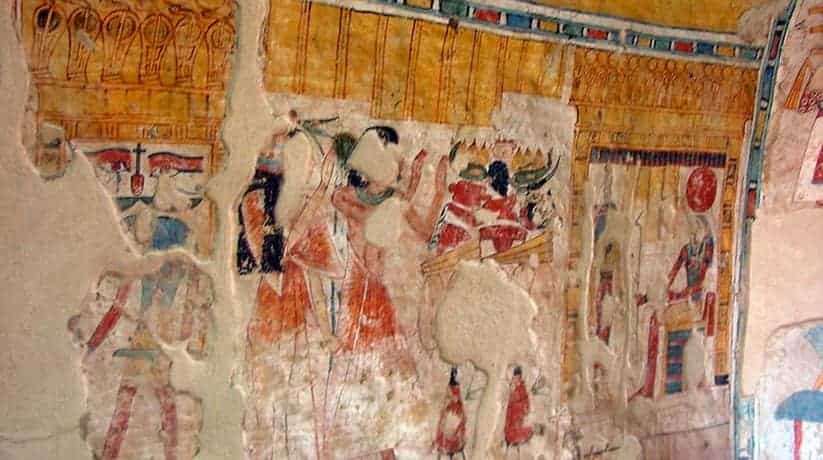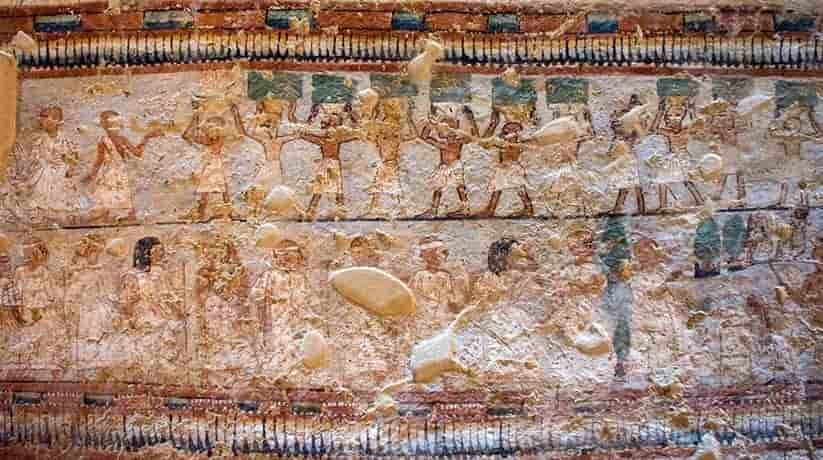Shuroy tomb Luxor TT 13 Egypt tours, prices, booking, reviews
Shuroy tomb Luxor referred to tomb TT13. It is a small, T- shaped and two chambered structure on the West Bank at Luxor. In fact, Shrouy tomb belongs to Shuroy and his wife, Wernefer. Moreover, Shrouy tomb located at Dra Abu el-Naga. Shrouy was the Head of the Brazier Bearers in the Temple of Amun at Karnak sometime during the 19th Dynasty. It is while his wife was a singer of Amun. Furthermore, Shrouy tomb characterized by scenes drawn, sometimes only in red ink outlines. They usually lack details. The coloration of Shuroy tomb Luxor is soft and almost pastels. It applied to a light gray or white background, with the heavy use of blue. In fact, Shrouy tomb Luxor unfinished, and a great part of its plaster work disappeared. It was the subject of a successful restoration in 2002.
The modern entrance to Shrouy tomb cut into the rear chamber. To view the paintings in the correct sequence, one must first move to the smaller vestibule. And then he must begin at Shuroy tomb’s original entrance. Upon entering Shrouy tomb Luxor, one will find a depiction of Shuroy and his wife in a pose of adoration. It is within the right thickness of the doorway. In fact, only the upper part of their bodies is now visible. Each faces toward the tomb. On the left hand thickness of the tomb’s door there is a woman. Her features only sketched in red pain. She appears to hold the sistrum of Hathor. At the first chamber of the tomb, the ceiling painted with two different geometric patterns. It also divided into panels. The panels separated from one another by thick and gold colored borders.
Further details about Shuroy tomb Luxor TT 13:
They also framed by white, red and black lines. Just below the ceiling, a thick yellow band. It also bordered by two red lines encircle the room. It separates the registers from the ceiling. The columns for hieroglyphs are present in Shuroy tomb Luxor. In addition, they separated by vertical blue and red lines. No text ever entered. In the first chamber of Shuroy, the first quarter of the left wall not completed. It also lacks even the plaster that would have applied. Even so, the artists painted over the unfinished wall using red ocher to outline the scenes. On the left side of the chamber, in the upper register, are scenes from the Book of Gates. They also depict Shuroy and his wife before various deities. In fact, the first parts of these scenes unfinished.
In the finished parts the curled wig of the wife surmounted by a lotus flower. She wears a transparent dress. At the center of the left wall in Shuroy tomb Luxor, the couple stands before a table of offerings. They laden with various items including breads and meats. The items also include mandrakes, grapes and cucumbers. To the right, Re-Harakhty, holding a scepter and an ankh-sign. He sits in a kiosk holding an ankh symbol and a was-scepter. The kiosk adorned. In addition, he faces left toward a standing figure of the goddess Ma’at. Though the god’s figure well painted. Furthermore, his arms and legs are long and thin. It makes the scene appear to be a caricature rather than a formal ancient Egyptian drawing. The front wall and the right side wall of Shruoy tomb continue the representations from the Book of Gates.
More details about Shuroy tomb Luxor TT 13:
In fact, it is as if they were one wall. Moreover, they are with various genie which shown in the same order as on the left wall. The scenes begin on the front wall. They are with a damaged depiction of Shuroy who holds a stem of papyrus in his right hand. Before him is a door, but also the representation of a genie. The genie stands on a pedestal with a scepter in his hand. As on the left wall, the couple moves on from gate to gate within these scenes. Also as on the left wall of Shuroy tomb Luxor, we find Shuroy with a shaven head. He dressed in a loincloth, facing another kiosk, or shrine. About him are tables of offerings. This time, the shrine contains Osiris, with dark green flesh, as he often painted.
In front of Osiris, rising from a lotus flower, are the Four Sons of Horus. On the left side of the chamber’s rear wall, a large, damaged, personified djed-pillar. It surmounts a large hieroglyph meaning “the West”. It clothed in linen and a red sash, and holds the crook and flail. Then, on the right side of the rear wall, we find a similar personified djed-pillar. Below this one shaped loaves of bread and vessels. The depiction of the bread loaves well drawn. There are also small dots which painted across the bread’s surface. They like those made by modern Upper Egyptian women when baking at home. Moreover, they claim that the holes ensure that the loaves bake. On the thickness of the doorway of the second chamber, there are also two figures which destroyed. They are also of Shuroy and his wife. Moreover, they drawn in red ink only.
Further details about Shuroy tomb Luxor TT 13:
Moreover, the second chamber of Shuroy tomb Luxor has short walls at the north and south. They not decorated, or at least no longer decorated. In fact, they used to be the entrance to the tomb. The ceiling of this chamber decorated with a light yellow and white checkerboard pattern. In addition, a series of red and yellow circles arranged in large squares. Within the second chamber, four registers adorn the long front wall to the right of the door. In the upper register, twenty two male offering bearers stride forward. Moreover, Nineteen of them carry large, painted boxes on their heads. The three others have bundles of vegetables. The next register, Shuroy and an unknown male relative shown approaching a garden. To the right, a small group of drawn trees, with servants sitting beneath them.
The servants all are holding their heads in their hands, as if sleeping. In the next lower register, a funeral procession proceeds forward with servants bearing foodstuffs. It is while others are squatting before baskets of vegetables. Furthermore, at the right side of the scene, men carry a yoke on their shoulders to which chests attached. It is as a cow walks to the right of them. In these scenes, there is a distinct separation between nobles bearing offerings. The servants who toil with the majority of offerings and funerary equipment. Moreover, the rich clothing of the nobles distinguishes them from the simple bearers. It is with their loincloths who follow them. In the lowest register, the procession continues. It is with young, naked girls dancing beside their mother in the center of the register.
More details about Shuroy tomb Luxor TT 13:
In fact, their hands are in the air. Furthermore, their knees bent as if they jump or skip. Shuroy’s mummy stands at the right end of the wall, with a group of male bearers walking toward the mummy. Mourning women kneel at his feet, wailing and pouring dirt on their heads. At the top left of the rear wall, a priest grasps instruments. They used in the Opening of the Mouth ritual. In addition, a female mourner stands in front of the mummy, along with other women. Below this, Shuroy seen kneeling and holds braziers. It is before a figure of Hathor, shown as a cow with an elaborate plumed headdress. She is emerging from a mountain.
Within the central niche in the rear wall, there is a figure of a squatting man on the right. Shuroy is behind the man, offering braziers. Behind him is his wife and another male who unidentified. There were women who depicted to the left of Shuroy. To the right of the niche, Thoth leads Shuroy before a seated figure of Osiris. It accompanied by Isis and Nephthys. Below this, a scene of libation which almost completely destroyed. Shuroy tomb Luxor well restored and does have vivid colors. Though incomplete, its unfinished nature is also instructive from an artistic standpoint.
Entrance to Shuroy tomb Luxor:
The tomb opens from 8 am to 4 pm in winter. A ticket for the Dra Abu el-Naga tombs. It includes Roy tomb and also Shuroy tomb Luxor. It costs 60 Egyptian pound and can bought at the ticket office.
















